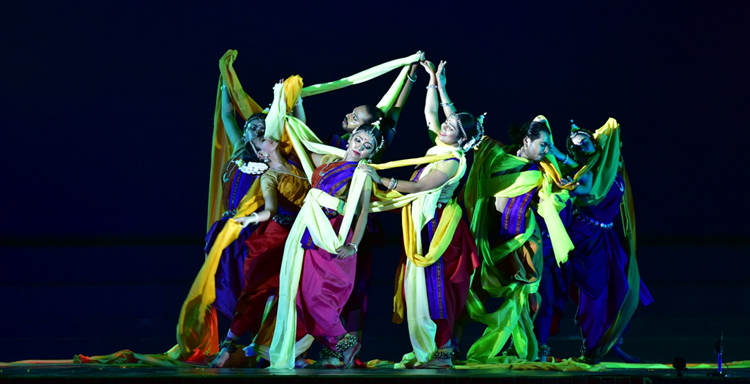Last month aficionados of dance were witness to the 16th Dhauli Kalinga Mahotsav of dance- a joint venture of Orissa Dance Academy and Odisha Tourism in association with Art Vision, Bhubaneswar.
Organized at the foothills of ancient Dhauli since the year 2003, The Dhauli-Kalinga Mahotsav has been able to create an identity for itself and got its due prominence in the cultural map of India. The festival is a unique confluence of more than 500 artistes belonging to various art forms of Indian dance tradition and it celebrates ‘Unity in diversity’. The Dhauli peace Pagoda as the backdrop of stage inspires the artistes to cherish the idea of love, peace, compassion and humanity. The objective of the festival is to preserve, promote and popularize Indian Classical dance heritage of the country globally.
After a grand inauguration, the first piece of dance presented was in Odissi style. Pallavi was an Offering of Orissa Dance Academy & Srjan, Bhubaneswar to Guru Kelucharan Mohapatra.
Orissa Dance Academy (ODA) an institution founded by Guru Gangadhar Pradhan is dedicated to the education and promotion of Odissi dance, music and other related art forms. Presently led by Aruna Mohanty, ODA’s renowned repertory ensemble has enthralled audiences all over the world with its innovative group compositions.
Srjan- Guru Kelucharan Mohapatra Odissi Nrityabasa, is one of India’s premier Odissi dance institutions. Sri Ratikant Mohapatra, the artistic director of Srjan, works towards creating awareness about Odissi dance with a modern approach while preserving the rich classical element of the art. Srjan ensemble is known for its fast-paced movements, innovations in dance and music, and the depiction of popular themes.

ODA and Srjam performed Pallavi in Raga- Sankaravaran & Taal- Ek tali, Raga- Kirvani & Taal- Khemata & Raga- Hamshadhwani & Taal- Ek tali. It was a pure dance Composition of Guru Kelucharan Mohapatra, accompanied with Pt. Bhubaneswar Mishra’s music composition. Dance Choreography was by Guru Aruna Mohanty & Guru Ratikanta Mohapatra.
Unfortunately, I missed seeing this Pallavi presented with the joint choreographic effort of ODA Guru Aruna Mohanty and Srjan Guru Ratikant Mohapatra-two very bright stars in the Odissi firmament, because of reaching Bhubaneswar late.
Kathak dancer Rajashree Shirke of Lasya Centre For Dance Education and Research, Mumbai presented Sant Kanhopatra.

Contemporary Dancer Astad Deboo & group, Mumbai presented ‘Unbroken, Unbowed’ on a few chosen and significant quotes of M.K. Gandhi, which have ever been a source of inspiration to him.
The piece Shanti Mantra by ODA was perhaps the most needed and unique production, coming at a time when the country is beset with divisiveness and chaos. More than ever peace and amity is the need of the hour. There was so much of beauty in the very concept itself, as visualized by Aruna Mohanty-helped by Guru Ramesh Chandra Jena in directing the dance assisted by Guru Pabitra Kumar Pradhan, Prashanta Behera & Rudra Prasad Swain. The vision of aesthetics in every sphere of life prevailed. The physical body was the material through which poetry was etched on the stage. Guests were received with plants as a gesture to reveal man’s existence in nature. Peace was invoked-rendered spectacularly with gotipua stances friezes. The sprinkling of flowers with perfect tribangi and chauka stances were aesthetically appealing.
Odissi Vision and Movement Centre, Kolkata with Sharmila Biswas, a leading dancer and choreographer at the helm of affairs displayed her versatility, which ranges from classical Odissi dance to experimental choreographic work.
Kalaripayatu artist Ranjan Mullaratt of Kalari Academy of Performing Arts, Bangalore performed here with his repertory members. The aim of the institution is to preserve and endorse the virtues of traditional Kalaripayattu martial arts. Ancient Martial Art form evolved in south India from animal movements and commonly known as the mother of all martial arts- Bodhidharma, a monk, is believed to have carried this art to china from which the other martial arts evolved. When there was a fight between the local rulers called Naadu Vazhikal Kalari payattu fighters called chekavanmar, Like Gladiators, would fight to the death in what is called an Ankam. This used to save a lot of deaths and avoid wars. During the fight against the British, The Raja of Pazhassi used this art and killed a lot of British Soldiers by guerilla warfare. Now Kalarpayattu is a lifestyle more than a martial art. It is a way of self-expression. Kalaripayattu is being used by international dancers, theatre artists and film actors.

Mardeli is an institution imparted higher training of Mardala at Bhubaneswar. This institution is led by Guru Sachidananda Das, who is an internationally acclaimed Mardala player known for his effortless execution of melodious strokes. Guru Sachidananda’s group of well-versed students of Orissa Research Academy could have been even better than what they did, with a little bit of their imagination in playing the eleven beat rhythm to avoid monotony.
Acclaimed Bharatanatyam dancer-a disciple of Yamini Krishnamurthy-Rama Vaidyanathan of Ganesa Natyalaya, New Delhi who has over the years, developed a style of her own performed here with her repertory members. Bodhana the invocatory composition, was akin to her composition of the Marathi Abhang, ‘Utha Panduranga’, which I had witnessed some years back. In Bodhana she summoned friends and devotees to accompany her to the temple of Lord Shiva at dawn when the temple bell summons and the rooster welcomes the morning. Waking up to go to the Temple is symbolic of awakening to spiritual consciousness. Verses from Thiruvempavai written by Maanikka Vaachakar put in dance vocabulary infused magic. Music composition was by Sudha Raghuraman.

Hindi Bhajan ‘Bhayilli Piya’ by Maharaja Swati Tirunal, where a nayika spends a whole night expressing her love for Lord Krishna on two levels. One is Erotic Sringara where she wants to physically unite with him, and the other is Bhakti Shringara where she wants to spiritually become one with him-danced by her group. Sringara and bhakti, or devotion laced with passion are two sides of the same coin. When a nayika expresses her intense longing for Krishna, it is actually her inner self that is yearning for the supreme consciousness. When she undresses for him, she is actually surrendering her soul to the Brahman. When she gazes at him she is meditating on the ultimate truth. The duality of Sringara Bhakti was well expressed in this composition. The music composition was by Sudha Raghuraman. The words are “Oh my Love, it is a moonlit night, please stay with me”.
‘Bindu’ was the grand finale and this was about the mystical quality of Shiva and Shakti. Philosophically speaking, Shiva cannot move without the presence of Shakti. It is only when the two forces integrate that the sacred point of creation the Bindu, emerges. The divine union initiates all cosmic movement that is represented by intersecting triangles and concentric circles. When the two energies unite they instigate pulsating energy that expands and contracts. When both Shiva and Shakti engage in intimacy, it is like the sun and the moon uniting. Music by G S Rajan. Lyric from Adi Sankara Harya’s Soundarya Lahiri and Punya Nandanatha’s Kama Kalavilasa.
Mayurbhanj Chhau by Bibhudatta Das & Group was by Maa Vairabi Chhau Nrutya Pratisthan, Mohanpur, Moroda, Mayurbhanj in the year 1968, to develop Mayurbhanj Chhau. It was formed by the Sardar family of Mohanpur, Bholaghaty, Mayurbhanj to patronage the, post the Merger of the State of Mayurbhanj in the Republic of India. However, with time the family migrated to Baripada and Bhubaneswar. Sri Bibhudatta Das revived it in 2018 and formed a group of Mayurbhanj Chhau that exclusively performs the Martial dance items like Ruk Maar, Jodi Ranga Panda Khatriya Bandhu and Parasuram. This Institution appreciates the ‘Parikhanda’ Style of Mayurbhanj Chhau keeping their inheritance in perspective.
One of the most popular and acclaimed group presentations of Mayurbhanj Chhau repertoire, war dance is popularly known as the Ruk –Maar was conceptualised in the early years of evolution of Mayurbhanj Chhau. In the year 1902 during the rule of maharaja Shri Ram Chandra Bhanjdeo, the group of artists were divided into two groups of front line soldiers and fight against each other with sword and shield. This dance is a highly stylized martial mock fight. After facing multiple invasion the different princely states of Kalinga, Mayurbhanj, being the largest one, decided to increase the number count of their war foot army and started imparting war techniques to people from all community. That is how this dance item ‘Khatriya Bandhu’ is choreographed. This dance item depicts how the militaria of the erstwhile Royal State of Mayurbhanj was excellent in war techniques, martial art and body fitness. Their skills left the audience and their enemies mesmerized and therefore the Maharajas were proud of the ‘Khetriya’ community and use to keep them in the Royal army providing all types of facilities.

A very thoughtful way of disseminating knowledge of classical art was seen at this festival. Many educational and training institutions were invited to be a part of the festival. It not only helped to fill up audience space but also created rasikas. Awards were given in various disciplines for the sustenance of their interest. Among the chosen awardees for various disciplines was Veteran Odissi stalwart Guru Mayadhar Raut, who was awarded the Ruchi Buddha Samman. The Gangadhar Pradhan Smruti Samman 2019 was reserved for vocalist Guru Ghanashyam Panda, dance Guru Aloka Kanungo, Dr. Devi Mishra for promoting Odissi in Kolkata and U.S.A along with Dr. Niranjan Tripathy and Dr. Swati Tripathy, and light designer Jaydev Das received 2019 Samman in recognition of their work.










